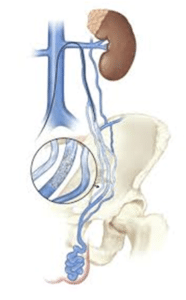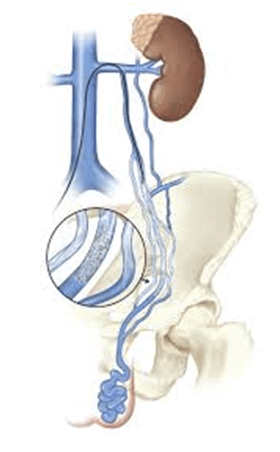Varicocele Embolization
A varicocele is a varicose vein of the testicle and scrotum that may cause pain, infertility in men, and possibly lead to testicular atrophy (shrinkage of the testicles). It is a condition that affects approximately 10 percent of men. In healthy veins within the scrotum, one-way valves allow blood to flow from the testicles and scrotum back to the heart. In a varicocele, these valves do not function properly and sometimes fail. This can cause a reverse flow of blood which stretches and enlarges the tiny veins around the testicle. This tangled network of blood vessels, or varicose veins, is called a varicocele.

What are Varicocele Symptoms?
Typical symptoms are mild and many do not require treatment. Treatment may be necessary if the varicocele is causing discomfort or any of the other problems listed below.
1.) Pain:
One of the signs of varicoceles is an aching pain when the individual has been standing or sitting for an extended time and pressure builds up in the affected veins. Heavy lifting may make varicocele symptoms worse and, in some cases, can even cause varicoceles to form.
2.) Fertility Problems:
There is an association between varicoceles and infertility or subfertility, but it is difficult to be certain if a varicocele is the cause of fertility problems in any one case. In one study, as many as 40 percent of men who were subfertile were found to have a varicocele. Other signs of varicoceles can be a decreased sperm count; decreased motility, or movement, of sperm; and an increase in the number of deformed sperm. It is not known for sure how varicoceles contribute to these problems, but a common theory is that the condition raises the temperature of the testicles and affects sperm production. Studies have shown that 50-70 percent of men with fertility problems will have a significant improvement in the quality and/or quantity of sperm production after they have undergone varicocele repair.
3.) Testicular Atrophy
Atrophy, or shrinking, of the testicles is another of the signs of varicoceles. The condition is often diagnosed in adolescent boys during a sports physical exam. When the affected testicle is smaller than the other, treatment is often recommended. The repaired testicle will return to normal size in many cases.
How are Varicoceles Diagnosed?
Sometimes a varicocele can be diagnosed during a physical examination. A large varicocele may make the scrotum look lumpy so it resembles “a bag of worms” (see Figure 2).
When varicocele symptoms are not clearly present, the abnormal flow of blood can often be detected with a varicocele ultrasound, a noninvasive imaging exam called color flow ultrasound. Varicoceles also may be detected with a venogram – an x-ray in which a special dye is injected into the veins to “highlight” blood vessel abnormalities.
What are my treatment options?
In the United States, varicocele treatment has traditionally involved open varicocele surgery, usually performed by a urologic surgeon, or urologist. In recent years, however, a safe and effective nonsurgical alternative called varicocele embolization is becoming the treatment of choice for many patients and their physicians.
Varicocele Embolization:
Varicocele embolization is a minimally invasive procedure performed by an interventional radiologist, and is as effective as surgery with less risk, less pain and less recovery time. Patients considering surgical treatment should also get a second opinion from us at the Vascular Institute of Virginia or another interventional radiologist to ensure they know all of their treatment options.
Unlike varicocele surgery, embolization requires no incision, stitches, or general anesthesia. In addition, embolization patients almost never require overnight admission to the hospital and several studies have shown that embolization is just as effective as surgery. Studies have also shown that embolization patients return to full activities in a day or two, but varicocele surgery patients may need to avoid strenuous activity for several days or even weeks. Some complications of varicocele surgery, such as hydrocele (fluid around that testicle) and infection are virtually unheard of after embolization.

Figure- A platinum coil, delivered through the catheter, is placed in the affected vein,
then a sclerosing agent is injected to block collateral veins. This helps to prevent recurrences.
During the embolization, the doctor inserts a catheter into the jugular vein, in the neck, down into the faulty vein(s). Catheterization requires only a small nick in the skin for insertion and x-ray image guidance of the catheter to its target area. The catheter delivers Dacron filaments-bearing coils that clot the blood and seal the faulty vein. The use of the recently developed Sotradecol foam agent allows the physician to block even the smallest veins not previously accessible.
Frequently Asked Questions regarding Varicocele:

